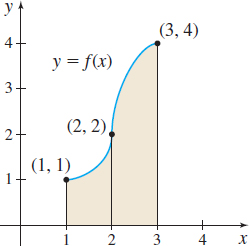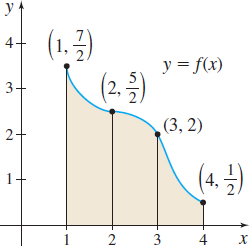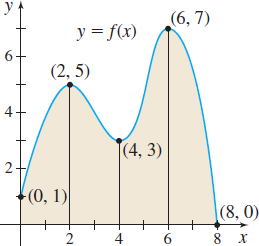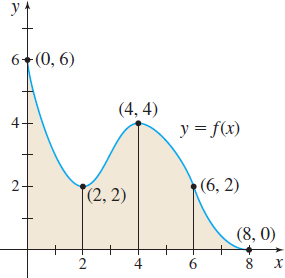5.1 Assess Your UnderstandingPrinted Page 350
Concepts and Vocabulary
Explain how rectangles can be used to approximate the area enclosed by the graph of a function \(y=f(x) \geq 0,\) the \(x\)-axis, and the lines \(x=a\) and \(x=b.\)
Answers will vary.
True or False When a closed interval \([a,b] \) is partitioned into \(n\) subintervals each of the same length, the length of each subinterval is \(\dfrac{a+b}{n}\).
False
If the closed interval \([-2,4]\) is partitioned into \(12\) subintervals, each of the same length, then the length of each subinterval is ______.
\(\dfrac{1}{2}\)
True or False If the area \(A\) under the graph of a function \(f\) that is continuous and nonnegative on a closed interval \([a,b] \) is approximated using upper sums \(S_{n}\), then \(S_{n}\geq A\) and \(A=\lim\limits_{n\rightarrow \infty }S_{n}.\)
True
351
Skill Building
Approximate the area \(A\) enclosed by the graph of \(f(x) = \dfrac{1}{2}x+3,\) the \(x\)-axis, and the lines \(x=2\) and \(x=4\) by partitioning the closed interval \([2, 4] \) into four subintervals: \[ \left[ 2, \dfrac{5}{2}\right], \left[ \dfrac{5}{2},3\right], \left[3, \dfrac{7}{2}\right], \left[ \dfrac{7}{2}, 4\right]. \]
- (a) Using the left endpoint of each subinterval, draw four small rectangles that lie below the graph of \(f\) and sum the areas of the four rectangles.
- (b) Using the right endpoint of each subinterval, draw four small rectangles that lie above the graph of \(f\) and sum the areas of the four rectangles.
- (c) Compare the answers from parts (a) and (b) to the exact area \(A=9 \) and to the estimates obtained in Example 1.
- (a) Area is \(\dfrac{35}{4}\).
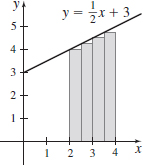
- (b) Area is \(\dfrac{37}{4}\).

- (c) \(\dfrac{35}{4}<9<\dfrac{37}{4}\)
Approximate the area \(A\) enclosed by the graph of \(f(x) =6-2x,\) the \(x\)-axis, and the lines \(x=1\) and \(x=3\) by partitioning the closed interval \([ 1,3] \) into four subintervals: \[ \left[1, \dfrac{3}{2}\right], \left[ \dfrac{3}{2},2\right], \left[ 2,\dfrac{5}{2}\right], \left[ \dfrac{5}{2},3\right]. \]
- (a) Using the right endpoint of each subinterval, draw four small rectangles that lie below the graph of \(f\) and sum the areas of the four rectangles.
- (b) Using the left endpoint of each subinterval, draw four small rectangles that lie above the graph of \(f\) and sum the areas of the four rectangles.
- (c) Compare the answers from parts (a) and (b) to the exact area \(A=4.\)
In Problems 7 and 8, refer to the graphs below. Approximate the shaded area under the graph of \(f\):
- (a) By constructing rectangles using the left endpoint of each subinterval.
- (b) By constructing rectangles using the right endpoint of each subinterval.
- (a) \(3\)
- (b) \(6\)
In Problems 9–12, partition each interval into \(n\) subintervals each of the same length.
\([1,4]\) with \(n = 3\)
\([1,2], [2,3]\), \([3,4]\)
\([0,9]\) with \(n = 9 \)
\([{-}1,4]\) with \(n = 10 \)
\(\left[-1,-\dfrac{1}{2}\right]\), \(\left[-\dfrac{1}{2},0\right]\), \(\left[0,\dfrac{1}{2}\right]\), \(\left[\dfrac{1}{2},1\right]\), \(\left[1,\dfrac{3}{2}\right]\), \(\left[\dfrac{3}{2},2\right]\), \(\left[2,\dfrac{5}{2}\right]\), \(\left[\dfrac{5}{2},3\right]\), \(\left[3,\dfrac{7}{2}\right]\), \(\left[\dfrac{7}{2},4\right]\)
\([{-}4,4]\) with \(n = 16\)
In Problems 13 and 14, refer to the graphs. Approximate the shaded area:
- (a) By using lower sums \(s_{n}\) (rectangles that lie below the graph of \(f\)).
- (b) By using upper sums \(S_{n}\) (rectangles that lie above the graph of \(f\)).
- (a) 14
- (b) 48
Area Under a Graph Consider the area under the graph of \(y=x\) from \(0\) to \(3\).
- (a) Sketch the graph and the area under the graph.
- (b) Partition the interval \([0,3]\) into \(n\) subintervals each of equal length.
- (c) Show that \(s_{n}=\sum\limits_{i=1}^{n}(i-1)\left(\dfrac{3}{n}\right)^{2}\).
- (d) Show that \(S_{n}=\sum\limits_{i=1}^{n}{i\left(\dfrac{3}{n}\right)}^{2}\).
- (e) Show that \(\lim\limits_{n\rightarrow \infty}s_{n}=\lim\limits_{n\rightarrow \infty } S_{n}={\dfrac{{9}}{{2}}}\).
- (a)
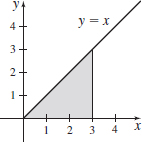
- (b) \(\left[0,\dfrac{3}{n}\right]\), \(\left[\dfrac{3}{n},2\cdot\dfrac{3}{n}\right],\ldots, \left[(n-1)\cdot\dfrac{3}{n},3\right]\)
- (c) See Student Solutions Manual.
- (d) See Student Solutions Manual.
- (e) See Student Solutions Manual.
Area Under a Graph Consider the area under the graph of \(y=4x\) from \(0\) to \(5\).
- (a) Sketch the graph and the corresponding area.
- (b) Partition the interval \([0,5]\) into \(n\) subintervals each of equal length.
- (c) Show that \(s_{n}=\sum\limits_{i=1}^{n}(i-1){\dfrac{100}{n^{2}}}\).
- (d) Show that \(S_{n}=\sum\limits_{i=1}^{n} i{\dfrac{100}{n^{2}}}\).
- (e) Show that \(\lim\limits_{n\rightarrow \infty} s_{n}={\lim\limits_{n\rightarrow \infty }}S_{n}=50.\)
In Problems 17–22, approximate the area \(A\) under the graph of each function \(f\) from \(a\) to \(b\) for \(n = 4\) and \(n = 8\) subintervals:
- (a) By using lower sums \(s_{n}\) (rectangles that lie below the graph of \(f\)).
- (b) By using upper sums \(S_{n}\) (rectangles that lie above the graph of \(f\)).
\(f(x) = -x+10\) on \([0,8]\)
- (a) \(s_4=40\), \(s_8=44\)
- (b) \(S_4=56\), \(S_8=52\)
\(f(x) = 2x + 5\) on \([2, 6]\)
\(f(x) = 16-x^{2}\) on \([0,4]\)
- (a) \(s_4=34\), \(s_8=\dfrac{77}{2}\)
- (b) \(S_4=50\), \(S_8=\dfrac{93}{2}\)
\(f(x) = x^{3}\) on \([0,8]\)
352
 \(f(x) = \cos x\) on \(\left[ -\dfrac{\pi }{2},\dfrac{\pi }{2}\right] \)
\(f(x) = \cos x\) on \(\left[ -\dfrac{\pi }{2},\dfrac{\pi }{2}\right] \)
- (a) \(s_4=\dfrac{\sqrt{2}}{4}\pi\approx 1.111\), \(s_8\approx 1.582\)
- (b) \(S_4=\dfrac{\sqrt{2}+2}{4}\pi\approx 2.682\), \(S_8\approx 2.367\)
 \(f(x) = \sin x\) on \([0,\pi]\)
\(f(x) = \sin x\) on \([0,\pi]\)
Rework Example 3 by using lower sums \(s_{n}\) (rectangles that lie below the graph of \(f\)).
\(s_n=\sum\limits_{i=1}^n \left(3(i-1)\dfrac{10}{n}\right)\dfrac{10}{n}=150-\dfrac{150}{n}\); \(\lim\limits_{n\to \infty} s_n=150\)
Rework Example 4 by using upper sums \(S_{n}\) (rectangles that lie above the graph of \(f\)).
In Problems 25–32, find the area \(A\) under the graph of \(f\) from \(a\) to \(b\):
- (a) By using lower sums \(s_{n}\) (rectangles that lie below the graph of \(f\)).
- (b) By using upper sums \(S_{n}\)(rectangles that lie above the graph of \(f\)).
- (c) Compare the work required in (a) and (b). Which is easier? Could you have predicted this?
\(f(x) =2x+1\) from \(a = 0\) to \(b = 4 \)
- (a) \( A = \lim\limits_{n\to \infty} s_n =\lim\limits_{n\to \infty} \left(20- \dfrac{16}{n}\right)=20\)
- (b) \( A = \lim\limits_{n\to \infty} S_n =\lim\limits_{n\to \infty} \left(20 + \dfrac{16}{n}\right)=20\)
- (c) Answers will vary.
\(f(x) = 3x+1\) from \(a=0\) to \(b=4\)
\(f(x) =12-3x\) from \(a = 0\) to \(b = 4\)
- (a) \(A = \lim\limits_{n\to \infty} s_n =\lim\limits_{n\to \infty} \left(24-\dfrac{24}{n}\right)=24\)
- (b) \(A = \lim\limits_{n\to \infty} S_n =\lim\limits_{n\to \infty} \left(24 + \dfrac{24}{n}\right)=24\)
- (c) Answers will vary.
\(f(x) =5-x\) from \(a = 0\) to \(b=4\)
\(f(x) = 4 x^{2}\) from \(a = 0\) to \(b = 2\)
- (a) \(A = \lim\limits_{n\to \infty} s_n =\lim\limits_{n\to \infty} \left(\dfrac{32}{3}-\dfrac{16}{n}+\dfrac{16}{3n^2}\right)=\dfrac{32}{3}\)
- (b) \(A = \lim\limits_{n\to \infty} S_n =\lim\limits_{n\to \infty} \left(\dfrac{32}{3}+\dfrac{16}{n}+\dfrac{16}{3n^2}\right)=\dfrac{32}{3}\)
- (c) Answers will vary.
\(f(x) = \dfrac{1}{2}x^{2}\) from \(a = 0\) to \(b=3\)
\(f(x) = 4 - x^{2}\) from \(a = 0\) to \(b = 2\)
- (a) \(A = \lim\limits_{n\to \infty} s_n =\lim\limits_{n\to \infty} \left(\dfrac{16}{3}-\dfrac{4}{n}-\dfrac{4}{3n^2}\right)=\dfrac{16}{3}\)
- (b) \(A = \lim\limits_{n\to \infty} S_n =\lim\limits_{n\to \infty} \left(\dfrac{16}{3}+\dfrac{4}{n}-\dfrac{4}{3n^2}\right)=\dfrac{16}{3}\)
- (c) Answers will vary.
\(f(x) = 12-x^{2}\) from \(a = 0\) to \(b = 3\)
Applications and Extensions
In Problems 33–38, find the area under the graph of \(f\) from \(a\) to \(b.\) [Hint: Partition the closed interval \([a,b]\) into \(n\) subintervals \([x_{0},x_{1}],[x_{1},x_{2}],\) \(\ldots ,\) \([x_{i-1},x_{i}],\) \(\ldots , [x_{n-1},x_{n}],\) where \(a=x_{0}\lt x_{1}\lt\cdots \lt x_{i}\lt\cdots \lt x_{n-1}\lt x_{n}=b,\) and each subinterval is of length \(\Delta x=\dfrac{b-a}{n}.\) As the figure below illustrates, the endpoints of each subinterval, written in terms of \(n\), are \[ \begin{eqnarray*} x_{0} &=& a, x_{1}=a+\dfrac{b-a}{n},\enspace x_{2}=a+2\left(\dfrac{b-a}{n}\right), \ldots , \\ x_{i-1} &=& a+(i-1) \left(\dfrac{b-a}{n} \right),\enspace x_{i}=a+i\left(\dfrac{b-a}{n}\right), \ldots ,\\ x_{n} &=& a+n \left(\dfrac{b-a}{n}\right) \end{eqnarray*} \]

\(f(x)=x+3\) from \(a = 1\) to \(b=3\)
\(10\)
\(f(x)=3-x\) from \(a=1\) to \(b=3\)
\(f(x)=2x+5\) from \(a=-1\) to \(b=2\)
\(18\)
\(f(x)=2-3x\) from \(a=-2\) to \(b=0\)
\(f(x) = 2x^{2}+1\) from \(a = 1\) to \(b = 3\)
\(\dfrac{58}{3}\)
\(f(x) = 4-x^{2}\) from \(a = 1\) to \(b = 2\)
![]() In Problems 39–42, approximate the area \(A\) under the graph of each function \(f\) by partitioning \([a,b]\) into \(20\) subintervals of equal length and using an upper sum.
In Problems 39–42, approximate the area \(A\) under the graph of each function \(f\) by partitioning \([a,b]\) into \(20\) subintervals of equal length and using an upper sum.
\(f(x)=xe^{x}\) on \([0,8]\)
\(A\approx 25{,}994\)
\(f(x)=\ln x\) on \([1,3] \)
\(f(x)=\dfrac{1}{x}\) on \([1,5]\)
\(A\approx 1.693\)
\(f(x)=\dfrac{1}{x^{2}}\) on \([2,6]\)

- (a) Graph \(y=\dfrac{4}{x}\) from \(x=1\) to \(x=4\) and shade the area under its graph.
- (b) Partition the interval \([1,4] \) into \(n\) subintervals of equal length.
- (c) Show that the lower sum \(s_{n}\) is \(s_{n}=\sum\limits_{i=1}^{n}\dfrac{4}{\left( 1+\dfrac{3i}{n}\right) }\left(\dfrac{3}{n}\right).\)
- (d) Show that the upper sum \(S_{n}\) is \[ S_{n}=\sum\limits_{i=1}^{n}\frac{4 }{\left( 1+\frac{3(i-1) }{n}\right) }\left( \frac{3}{n} \right) \]
- (e) Complete the following table:
\(n\) \(5\) \(10\) \(50\) \(100\) \(s_{n}\) \(S_{n}\) - (f) Use the table to give an upper and lower bound for the area.
- (a)
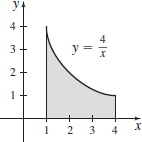
- (b) \(\left[1,1+\dfrac{3}{n}\right],\left[1+\dfrac{3}{n},1+2\cdot\dfrac{3}{n}\right],\ldots, \left[1+(n-1)\cdot\dfrac{3}{n},4\right]\).
- (c) See Student Solutions Manual.
- (d) See Student Solutions Manual.
- (e)
\(n\) \(5\) \(10\) \(50\) \(100\) \(s_n\) 4.754 5.123 5.456 5.500 \(S_n\) 6.554 6.023 5.636 5.590 - (f) \(5.500\le A \le 5.590\)
Challenge Problems
Area Under a Graph Approximate the area under the graph of \(f(x)=x\) from \(a\geq 0\) to \(b\) by using lower sums \(s_{n}\) and upper sums \(S_{n}\) for a partition of \([a,b]\) into \(n\) subintervals, each of length \(\dfrac{b-a}{n}\). Show that \[ s_{n}\lt \frac{b^{2}-a^{2}}{2}\lt S_{n} \]
Area Under a Graph Approximate the area under the graph of \(f(x)=x^{2}\) from \(a\geq 0\) to \(b\) by using lower sums \(s_{n}\) and upper sums \(S_{n}\) for a partition of \([a,b]\) into \(n\) subintervals, each of length \(\dfrac{b-a}{n}\). Show that \[ s_{n}\lt \frac{b^{3}-a^{3}}{3}\lt S_{n} \]
See Student Solutions Manual.
Area of a Right Triangle Use lower sums \(s_{n}\) (rectangles that lie inside the triangle) and upper sums \(S_{n}\) (rectangles that lie outside the triangle) to find the area of a right triangle of height \(H\) and base \(B.\)
Area of a Trapezoid Use lower sums \(s_{n}\) (rectangles that lie inside the trapezoid) and upper sums \(S_{n}\) (rectangles that lie outside the trapezoid) to find the area of a trapezoid of heights \(H_1\) and \(H_2\) and base \(B\).
See Student Solutions Manual.

